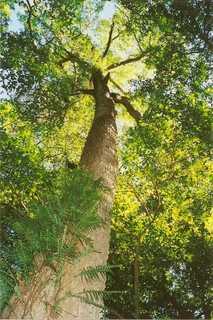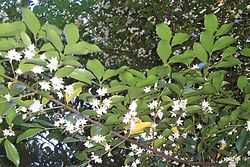Doryphora sassafras
| Doryphora sassafras | |
|---|---|
 | |
| Doryphora sassafras at its southernmost limit of distribution near Eden, Australia | |
| Scientific classification | |
| Kingdom: | Plantae |
| (unranked): | Angiosperms |
| (unranked): | Magnoliids |
| Order: | Laurales |
| Family: | Atherospermataceae |
| Genus: | Doryphora |
| Species: | D. sassafras |
| Binomial name | |
| Doryphora sassafras Endl. | |
Doryphora sassafras, commonly known as Sassafras, Yellow-, Canary- or Golden sassafras, or Golden Deal, is a species of evergreen tree of the family Atherospermataceae native to the subtropical and temperate rainforests of eastern New South Wales and Queensland, Australia. It is a tall tree with green foliage and contrasting white flowers which occur in Autumn and Winter.
Taxonomy
Doryphora sassafras was first described by Austrian naturalist Stephan Endlicher in 1837.[1] Its generic name is derived from the Ancient Greek dory- "spear" and pherein "to carry", and refers to the anthers in the flower, while its specific epithet is taken from its similar odour to the North American Laurel (Sassafras albidum).[2] It is a member of the small family Atherospermataceae along with several other Australian rainforest trees including southern sassafras (Atherosperma moschatum). Common names include Canary Sassafras, Yellow Sassafras, Golden Sassafras, Golden Deal or simply Sassafras.[1]
Description
Doryphora sassafras can grow to a height of 25-35;metres.[3] It is a straight-trunked tree generally with a small crown, its grey-brown trunk reaching a diameter of 1.2 m (4 ft). Oppositely arranged on the stem, the green leaves are elliptic to lanceolate or ovate, usually 7–10 cm (3–4 in) long, 2–4 cm wide, margins are shallowly to deeply toothed, glabrous and glossy, with a pleasant 'sassafras' scent when crushed. They have a prominent midrib and veins on the paler underside. The small white flowers occur in groups of three on short axillary stalks from May to July, and are followed by dark brown hairy fruit which are ripe from February to August.[2] The flowering display can be showy with flowers massed on branches. contrasting against the darker foliage.[4]
Distribution and habitat
The distribution is from Nambour in southern Queensland through eastern New South Wales to Wolumla Peak in Yurammie State Forest. It is found in temperate rainforest on basalt soils at higher elevations and sedimentary soils at lower elevations, commonly associated with Coachwood (Ceratopetalum apetalum) and native crabapple (Schizomeria ovata).[2]
Cultivation and uses
The yellowish soft timber is used in floors, turnery, and cabinet work.[2] It is used in reforestation but generally grows too big to be used in home gardens. It has been thought to have potential as a potted specimen.[5] It has been planted in Dublin area in Ireland[6]
Gallery
-

Sassafras flowers and leaves, St Ives North, Australia
-

Sassafras flowers and leaves
-

Sassafras flowers and leaves, St Ives North, Australia
References
- ↑ 1.0 1.1 "Doryphora sassafras". Australian Plant Name Index (APNI), IBIS database. Centre for Plant Biodiversity Research, Australian Government.
- ↑ 2.0 2.1 2.2 2.3 Floyd, Alex G. (2009). Rainforest Trees of Mainland Southeastern Australia. Lismore, NSW: Terania Rainforest Publishing. pp. 87–88. ISBN 978-0-9589436-7-3.
- ↑ Floyd, A.G. 1990: Australian Rainforests in New South Wales, Volume 1. Surrey Beatty & Sons Pty Ltd, Chipping Norton, NSW.
- ↑ Fairley A, Moore P (2000). Native Plants of the Sydney District: An Identification Guide (2nd ed.). Kenthurst, NSW: Kangaroo Press. p. 53. ISBN 0-7318-1031-7.
- ↑ Elliot, Rodger W.; Jones, David L.; Blake, Trevor (1989). Encyclopaedia of Australian Plants Suitable for Cultivation: Vol. 3. Port Melbourne: Lothian Press. p. 331. ISBN 0-85091-167-2.
- ↑ "Climatic zone plants". Earlscliffe. Retrieved 2009-11-09.
- "Doryphora sassafras". PlantNET - NSW Flora Online. Retrieved 2008-11-19.